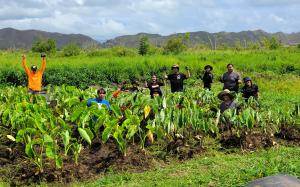VNR: UH summer research experience fosters next generation of NHPI scientists
University of Hawaiʻi at MānoaLink to video and sound (details below): https://bit.ly/3oWqOD5
A summer research program provided 11 Native Hawaiian and other Pacific Islander (NHPI) college students from across the Pacific a valuable opportunity to develop their scientific research skills while tackling challenges facing Pacific Island communities. The 10-week program, hosted by the University of Hawaiʻi at Mānoa, culminated with student presentations and a celebration at Ulupō Heiau State Historic Site on August 5.
The students performed cutting-edge research in environmental biology within the watershed of Kailua in Windward Oʻahu. Student projects focused on various topics including systems biology research to solve issues identified by the Kailua community, fishery science, sustainable agriculture systems, ecological restoration, invasive species science and management, and disease ecology. The place-based focus promoted science learning by linking it with Indigenous Pacific knowledge, fostering an opportunity for effective community engagement and encouraging collaboration among interns.
“As Indigenous researchers, our relationships to place, people and our ancestors are all intricately woven into our practice, understanding and interpretation of science,” said Kiana Frank, program co-lead and assistant professor in the Pacific Biosciences Research Center (PBRC) in the School of Ocean and Earth Science and Technology. “Our program is built on the foundation of pilina, infused with the intense intellectual rigor of learning ma ka hana ka ʻike (gaining knowledge by doing) huli ka lima i lalo (with our hands turned down) in both service and research to promote skills of kilo, pono science and mālama ʻāina.”
Student participants went through a rigorous application process. The accepted students had all of their expenses covered through a grant by the National Science Foundation, including travel costs, room and board, meals, transportation and other project expenses.
“I found it to exceed my expectations being a program of not just purely science-based, but implementing culture to our learnings,” said Carlene Blailes, a program participant, current student at Leeward Community College and a native of Guam. “Everyone in the program is especially friendly, and it was easy to build connections with one another and for me to come out of my shell. It truly is an outstanding program which pushes us to step out of our comfort zone, to get close to nature and understand the science behind it all.”
Christine Tominiko, a program participant, current student at UH Hilo and a native of American Samoa, added, “I’ve learned that science is a big contributor to the environment and we’ve done a lot of research this summer in order to better the environment around us.”
Training the next generation of NHPI scientists
NHPI are severely underrepresented in STEM majors and careers, greatly reducing the capacity to respond to challenges associated with global change. UH Mānoa experts said this is alarming since the small islands of the Pacific are expected to face disproportionate consequences of this global change, including sea level rise, coral reef loss, native species extinction, and increases in the frequency and intensity of storms.
“Access to contemporary technology that produces science is limited, but we’re dealing with a long lineage of excellent scientists, so much untapped potential,” said Matthew Medeiros, program co-lead and associate professor in PBRC. “A major goal of our program is to build good Pacific Island scientists.”
Medeiros added, “Knowledge has to return to the communities that need it. Knowledge has to return to the places that will benefit from it. Knowledge has to return to the people who helped create it with the scientists.”
Partnering with Kauluakalana
The program partnered with Kauluakalana, a non-profit community-based organization committed to natural resource restoration in Kailua, following culturally-informed protocols and integrating Hawaiian ways of knowing. Students worked with their mentors from several UH Mānoa colleges and departments (PBRC, Center of Microbiome Analysis through Island Knowledge and Investigation, School of Life Sciences, Department of Natural Resources and Environmental Management, Department of Tropical Plant and Soil Sciences), and Bishop Museum to perform research that helped to inform the objectives of Kauluakalana.
“It’s so meaningful to see them grow as young scientists, but see their projects develop and go deeper down into the microbes of the projects that they’re doing on ʻāina to help revive this area,” said Kaleo Wong, Kauluakalana executive director.
Link to video and sound (details below): https://bit.ly/3oWqOD5
BROLL: (1:57)
0:00-0:57 - Ceremony and student presentations on August 5 at Ulupō Heiau State Historic Site
0:58-1:57 - Fieldwork and research projects during the 10-week program
SOUNDBITES
(0:12)
Christine Tominiko, a program participant, current student at UH Hilo and a native of American Samoa
“I’ve learned that science is a big contributor to the environment and we’ve done a lot of research this summer in order to better the environment around us.”
(0:16)
Kiana Frank, program co-lead and UH Mānoa professor
“So many of our traditional values and cultural practices are models of sustainability for the whole world. So we’re trying to help students see that connection between culture and science, practice and sustainability.”

